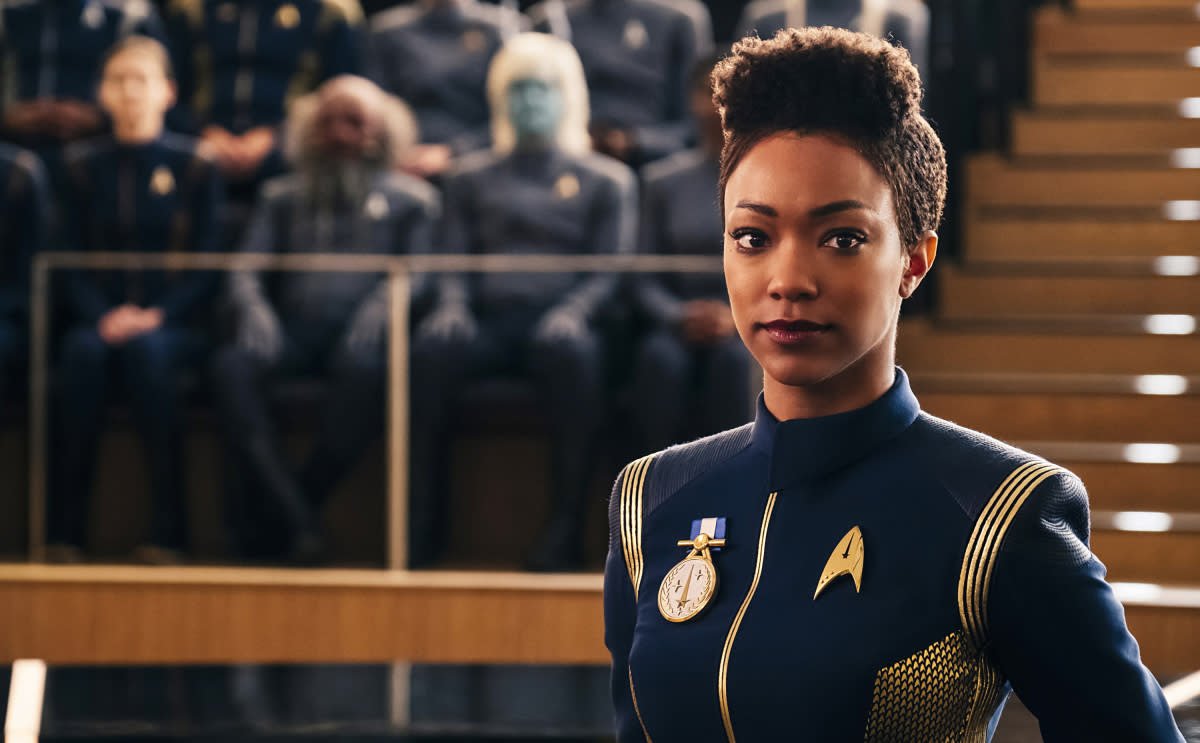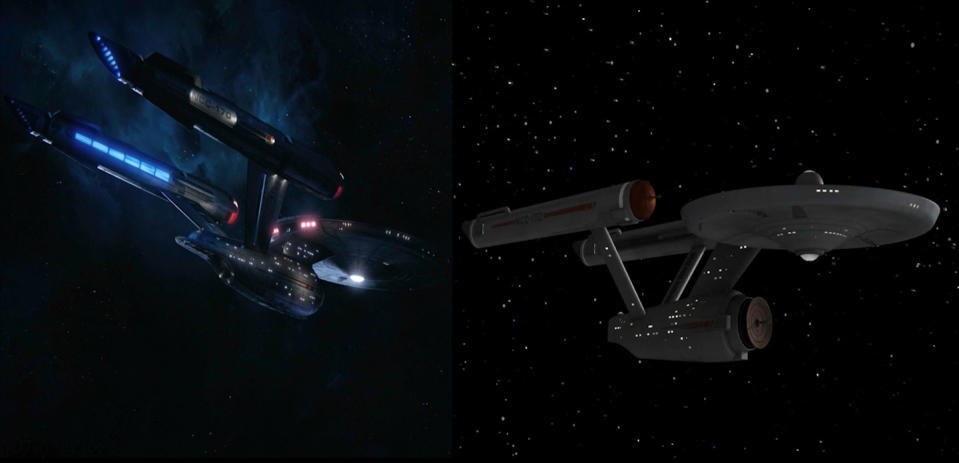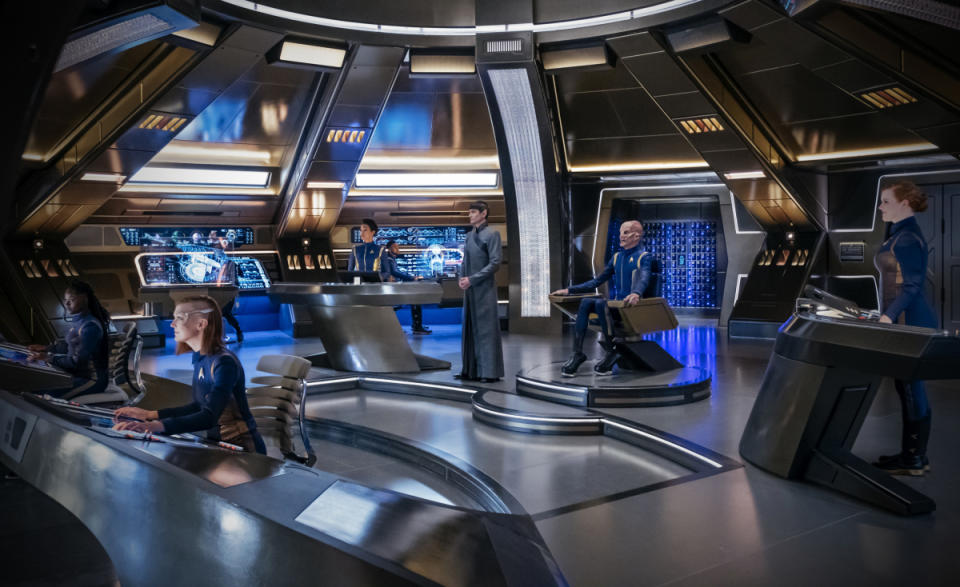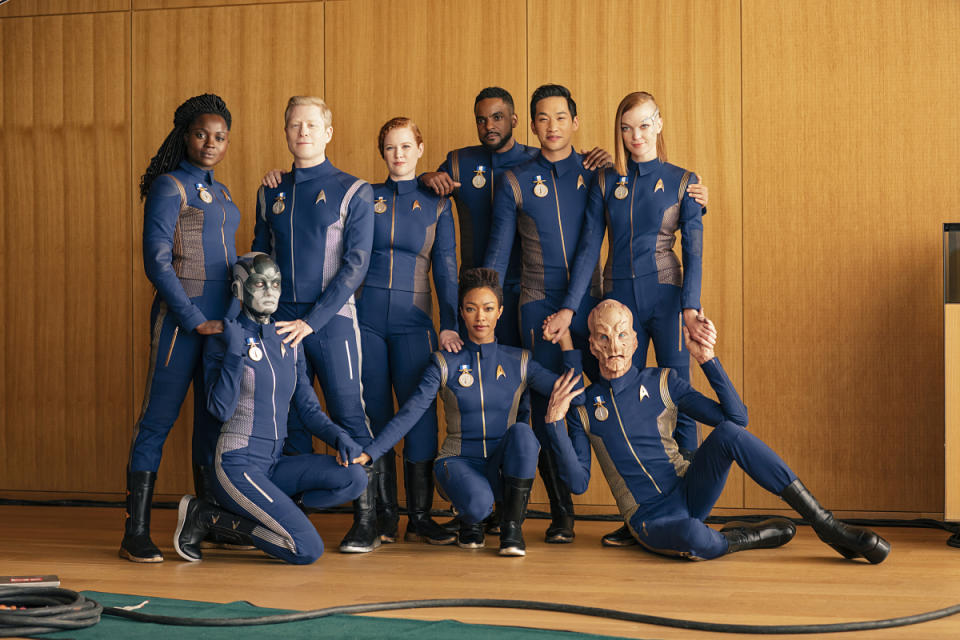Breaking down [spoiler]'s cameo in the 'Star Trek: Discovery' finale

Warning: This post contains spoilers for the Star Trek: Discovery Season 1 finale.
In the closing moments of its first season finale, Star Trek: Discovery boldly ventured into the final frontier: an up-close and personal encounter with the USS Enterprise, the most iconic ship in Starfleet. And this isn’t a next-generation Enterprise or one from an earlier era. This is the original series ship that James T. Kirk eventually inherits from its current captain, Christopher Pike. Yahoo Entertainment’s resident Trekkies beamed in to break down this major development, and speculate on what it means for the show’s future.
ADAM LANCE GARCIA: Last night, Star Trek: Discovery gave fans what they’ve been asking for throughout this admittedly uneven first season: a return of the ideals of the Federation and, more specifically, the return of the USS Enterprise. While the former, to my mind, not only addressed some of the series’ fundamental issues, it also threw into sharp relief that this first season wasn’t simply about Michael’s redemption; it was also about redeeming the Federation and why we still need those ideals. However, it is the arrival of the iconic, albeit revised, starship (accompanied by the show’s signature theme) that has us all talking.
As series co-creator and executive producer Alex Kurtzman stated in an interview with Variety, “[W]e recognize that the audience has a lot of questions about our synchronicity with the original series, which really means our synchronicity with canon. So the promise of the Enterprise holds the answers to a lot of those questions, including Spock’s relationship with his half-sister, whom he’s never mentioned.”
So, besides giving Zachary Quinto whatever he wants to reprise his role as a version of his cinematic Spock, what do you hope to see in Season 2’s crossover?

ETHAN ALTER: An Enterprise sighting was a trump card that I wasn’t sure whether Discovery‘s makers would necessarily want to play in Season 1. Now that it’s over, it’s pretty obvious that there’s no other way they could have ended this 15-episode run. As the first Star Trek TV series to air since they rebooted the feature film franchise with a new Kirk, Spock et al., Discovery exists in the long shadow cast by the Enterprise, and the show has tried to integrate both Gene Roddenberry’s and J.J. Abrams’s aesthetics into its own vision of the final frontier. That holds true for the version of the Enterprise we saw last night. It’s absolutely recognizable as the vintage NCC-1701, but also boasts the sleeker (and bluer) style favored by the Kelvin timeline crew. I have a feeling that when we see the interior next year, it’ll be a similar mixture of 1960s and 2010s futurism; and let’s not forget that this is still about 10 years before Kirk nabs the keys to the ship, so it’s still in relatively good shape.
In the moment, I really enjoyed the Enterprise flyby, especially since it was shamelessly (and unapologetically) accompanied by the classic TOS theme song. At the same time, it’s a cliffhanger that puts the showrunners in a challenging position, not entirely unlike the way that Ron Moore (who cut his creative teeth on Trek in the mid-’90s) deposited the Battlestar Galactica crew on Earth at the Season 4 halfway point, and then had to spend the back half of the season explaining why the show wasn’t over. Once you pull the trigger on an Enterprise/Discovery crossover, you can’t really do it again, and I think I would have preferred at least one more season-long solo flight by the Discovery before partnering it up with its sister ship. Especially since the show has sometimes struggled to find its own voice this year, explicitly bringing it into the TOS timeline could further dilute what makes Discovery stand apart.
Or, on the other hand, it could also definitively send the ship on its own path. To use a Battlestar Galactica analogy again, that show went to exciting new dramatic territory when the Galactica and the Pegasus briefly flew side by side. Seeing the dark things that went down aboard the Pegasus threw into sharp relief what made the Galactica a special ship. Perhaps an encounter with Captain Pike — and, maybe, Quinto’s Spock! — will help the showrunners more specifically define Michael Burnham’s place in the universe now that the Klingon War is over. Because what I want from Season 2, more than anything, is a Star Trek show that boldly goes to new regions of the franchise even at the risk of angering fans. After all, if I wanted warmed-over Trek rehash, I’d just watch The Orville. I watch Discovery to … well, discover how Trek can redefine itself for every new generation.

ADAM: Well, now that you’ve mentioned the Seth MacFarlane-shaped elephant in the room, let’s talk about it. Both Orville and Discovery explore the same basic concept: why we need the Federation’s progressive and inclusive ideals. But where Orville simply chose to do so with the surface-level re-creation of The Next Generation with a few more dick jokes, Discovery crafted a journey that ran against expectations to explore what Star Trek means in our pop culture — much like what The Last Jedi did for Star Wars.
A lot of the vitriol fans aimed at the first episodes reflected the characters’ own discomfort with the direction the Federation was taking in the war with the Klingons. They argued Orville “felt” like Star Trek, while Discovery didn’t — at least not initially. If Orville was comfort food, Discovery was a big bowl of quinoa and kale. Orville didn’t challenge the audience; it just gave them what they thought they wanted.
Conversely, by centering on Michael, someone who embodied all the Federation’s ideals only to undermine them, Discovery was able to reexamine many of the clichés we had become accustomed to in the Trek canon. From the sentient planets to the balls-to-the-wall journey through the Mirror Universe, Michael and the audience were shown in visceral ways what the Federation truly means to us.
If David Mack’s tie-in novel Desperate Hours is any guide, there is a lot of potential in the crossover between the Enterprise’s original-original crew and the Discovery’s. First, and foremost, there is the Spock-Michael-Sarek dynamic. Set about five years prior to the events of the series, the novel did an excellent job of showing Spock and Michael to be two sides of the same coin. Both of them felt lost in the cultures they were brought into, and both were equally jealous of — and damaged by — the other’s strained relationship with Sarek.
But more than that, I hope this crossover with the NCC-1701 and the NCC-1031 will continue Discovery’s exploration of the fundamental ideas at the center of Star Trek. What better way to show why we need Kirk than to show what the Enterprise was like before he took over the captain’s chair.
Also, I just really want to see those weird mock turtlenecks of 2254 again.

ETHAN: I’m glad you saw all of that in Discovery‘s first season. Watching episode to episode, I was too caught up in the breakneck, why-don’t-we-try-this plotting to really step back and think about What It All Means. One advantage that Season 2 should have over Season 1 is that there are no behind-the-scenes shakeups looming — at least at this point. We can only speculate what Bryan Fuller’s vision for the show might have been, and there was obviously a lot of trial and error as his successors tried to decide what their version of Discovery was going to be. Based on the finale, I still don’t think they necessarily know, but at least they have the off-season to paint a clearer picture.
Another lesson I hope they learn from this first year is how to better manage plot twists. They stepped on their own feet in the first half of the season when the Internet figured out the whole “Ash is Voq” twist early enough to rob that storyline of any suspense. And rather than just own up to it, the actor who played both parts, Shazad Latif, was required to publicly pretend that “Javad Iqbal” was a real person. Of course, because fan attention was so focused on that public face-plant, almost nobody saw the “Lorca’s Mirror Universe self is piloting the Discovery” reveal coming. Sad as I was to see Jason Isaacs go, that twist kicked the second half of the season into high gear and — along with a few other high-profile deaths — indicated that this was going to be the rare Trek show where regular crew shakeups are the status quo.
I think my preferred recipe for Season 2 would be: more new life and new civilizations, stronger standalone adventures (this year’s Groundhog Day-inspired one-shot was a season high point), all with the same amount of character complexity. Even when the storytelling faltered, Sonequa Martin-Green’s forceful performance as Burnham single-handedly held Discovery together, largely because Michael is unlike almost any other Starfleet protagonist we’ve seen before. She’s the reason why I’m looking forward to another year with the ship’s surviving crew members, as opposed to leaping forward in time as Fuller’s anthology-series approach would have dictated. No matter how their Enterprise encounter shakes out, the ingredients are there for Discovery to live long and prosper.
Season 1 of Star Trek: Discovery is currently streaming on CBS All Access.


